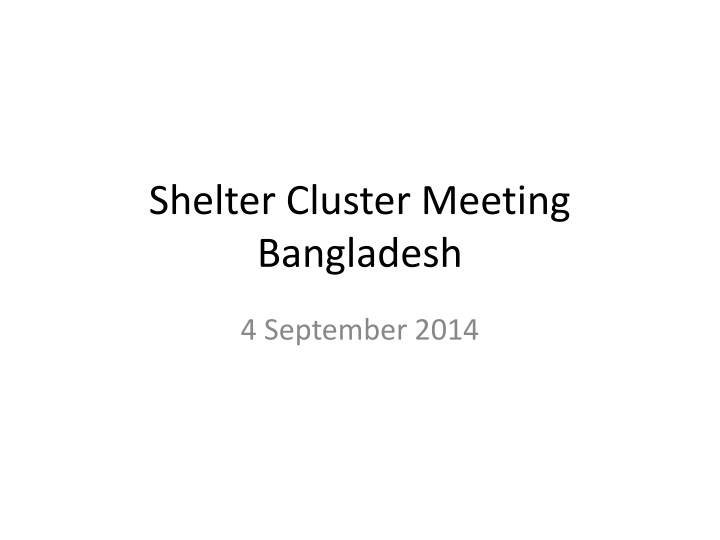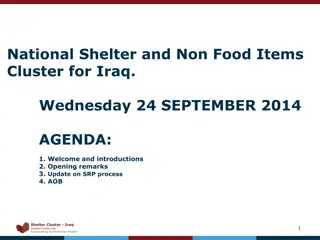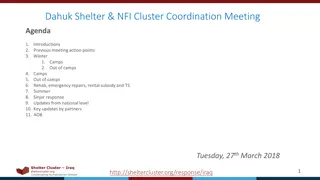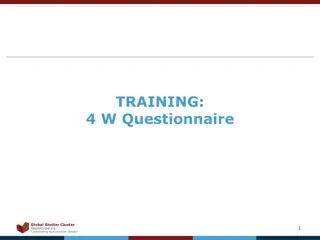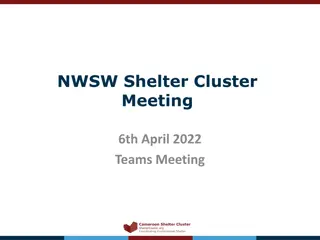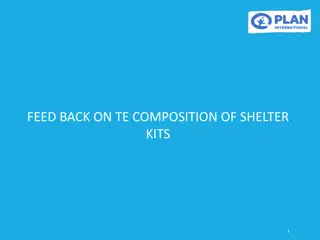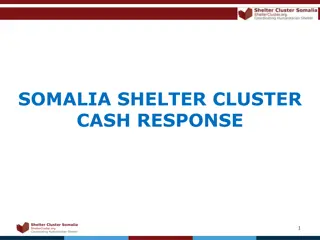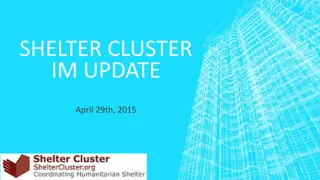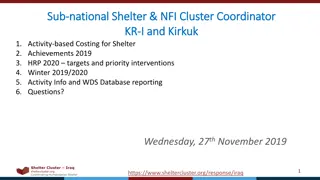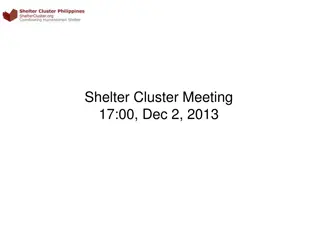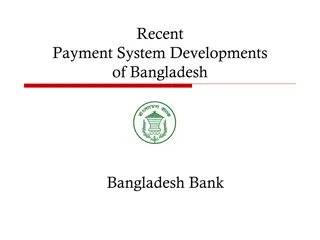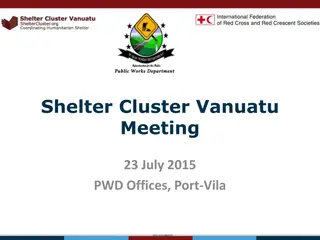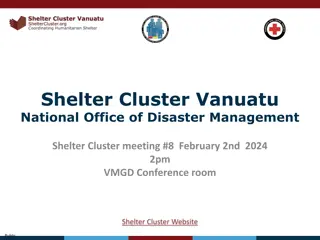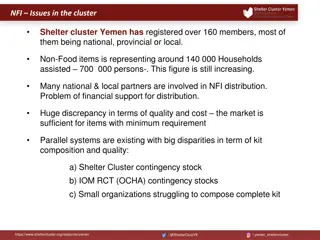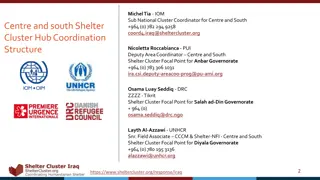Shelter Cluster Meeting in Bangladesh - September 2014
Following a Shelter Cluster Meeting in Bangladesh on September 4, 2014, key findings revealed that almost 2 million people were affected by flooding in nine districts, with priority needs including food, shelter, livelihoods, sanitation, and water. The overview highlighted the extent of individuals affected in each district, with Bogra, Gaibandha, and Kurigram among the most impacted. Immediate relief and recovery needs were identified, emphasizing the urgent requirement for assistance in affected areas, particularly in Bogra.
Uploaded on Mar 02, 2025 | 0 Views
Download Presentation

Please find below an Image/Link to download the presentation.
The content on the website is provided AS IS for your information and personal use only. It may not be sold, licensed, or shared on other websites without obtaining consent from the author.If you encounter any issues during the download, it is possible that the publisher has removed the file from their server.
You are allowed to download the files provided on this website for personal or commercial use, subject to the condition that they are used lawfully. All files are the property of their respective owners.
The content on the website is provided AS IS for your information and personal use only. It may not be sold, licensed, or shared on other websites without obtaining consent from the author.
E N D
Presentation Transcript
Shelter Cluster Meeting Bangladesh 4 September 2014
Assessment scope 9 North-western districts reported affected by flooding DMIC sit-rep I/NGO information
JNA Key findings Almost 2 million people are affected in the nine districts assessed this is 33% of the population in the affected area. In terms of priority districts: By percentage population affected: Bogra, Sirajgonj, and Gaibandha By numbers displaced: Kurigram: over 100,000 people are presently displaced Overall, food is the first priority reported by Union officials Other reported needs: livelihoods, sanitation, water, shelter
Overview: numbers affected Percent Individuals Affected Individuals Affected District Population Displaced Bogra 183499 111239 61% 20300 Gaibandha 818354 337459 41% 9408 Jamalpur 481502 140610 29% 11250 Kurigram 1684081 642264 38% 106911 Lalmonirhat 714867 81091 11% 6586 Nilphamari 257076 15815 6% 183 Rangpur 339742 64603 19% 14607 Sherpur 196074 50876 26% 102 Sirajganj 988690 423679 43% 34919 Total 5,663,885 1,867,636 33% 204,266
Immediate relief needs Immediate relief needs reported in Bogra, Sirajganj, Gaibandha, Jamalpur, Kurigram and Sherpur Unions report their own capacity to mange these needs is districts reported immediate relief needs inadequate In Bogra, 89% of unions out of the total affected areas for the district are in serious need of immediate relief assistance.
Recovery Needs Almost 90% of unions in Bogra indicating a serious need for recovery assistance over the coming months Percentage of Unions Recovery Needs in Coming Months serious need some need enough local capacities 100% 90% 80% 70% 60% 50% 40% 30% 20% 10% 0%
Key Findings Shelter Shelter is a concern in 160 unions (out of 215 that reported being affected out of the total 268 assessed) 42 Unions reported under shelter priority (Priority 1, 2,& 3) & Around 19,000 HH reported as IDP. Between 5% and 23% of the total population of the affected districts are in need of shelter assistance (this equates to between 68,137 and 312, 875 people) In the affected unions, most people are living in Collective centres/public buildings Kurigram (52 % of total displaced people) and Sirajgonj (17 % of total displaced people) have the most people displaced and displacedment is of greatest concern Ulipur, Char Rajibupr and Chilmari upazillas (in Kurigram district) have the most displaced people
Damage Information % of Total Affected People House Fully Damaged Affected Upazilla (No.) Affected People House Partially Damaged District Dhaka Faridpur Jamalpur Netrakona Tangail Bogra Sirajgonj Gaibandha Kurigram Lalmonirhat Nilphamari Rangpur Sunamgonj Rajbari Munshigonj Shylhet Manikgonj Total 1 3 3 3 8 3 4 3 6 5 1 3 4 5 3 3 3 61 4,100 4,190 153,731 20,500 110,565 75,175 195,468 121,230 152,000 29,356 16,885 10,800 44,500 26,475 2,867 128,630 0% 0% 14% 2% 10% 7% 18% 11% 14% 3% 2% 1% 4% 2% 0% 12% 0% 1,013 272 3,434 803 11,581 6,000 25,804 17,390 49,000 15,562 30,447 6,604 3,117 2,372 9,615 5,295 823 29,845 0 3,679 510 2,714 10,250 2,494 735 260 153 4,120 0 50 0 0 4,648 34,332 0 1,096,472 214,258 Reference : DMIC, Situation Report, 30th August, 2014.
Baseline shelter construction 100% 90% 80% 70% 60% % of Shelters Semi-pucka Kutcha 50% Jhupri 40% Pucka 30% 20% 10% 0% Bogra Gaibandha Jamalpur Kurigram Lalmonirhat Nilphamari Rangpur Sherpur Sirajganj
Shelter? reported? as? an? issue? (%? out? of? 215? affected? unions)? Total? 215? Unions? Sirajganj? 36? Unions? Sherpur? 7? Unions? Rangpur? 12? Unions? Nilphamari? 10? unions? Lalmonirhat? 28? Unions? Kurigram? 63? Unions? Jamalpur? 20? Unions? Gaibandha? 30? Unions? Bogra? 9? Unions? 0%? 10%? 20%? 30%? 40%? 50%? 60%? 70%? 80%? 90%? 100%? %? of? union?
Lalmonirhat Nilphamari Gaibandha Jamalpur Kurigram Sirajganj Rangpur Sherpur Bogra Reported living arrangement since the disaster Total Spontaneous settlement 44% 35% 71% 46% 56% 22% 29% 67% 56% 41% Other 78% 50% 35% 44% 48% 0% 71% 0% 56% 38% Original home 33% 27% 35% 43% 33% 56% 43% 83% 53% 36% Original village (house damaged) 44% 12% 12% 31% 4% 44% 43% 67% 61% 24% Collective center 0% 27% 18% 20% 4% 0% 43% 0% 22% 12% Formal Camp 0% 12% 6% 2% 0% 0% 0% 0% 6% 4% Number of union 9 26 17 61 27 9 7 6 36 198
Living Scenario Scenario 1 Took shelter on embankments, high ground, roads Scenario 2 in schools, in flood shelters Scenario 3 Neighboring houses. Scenario 4 In some locations people are reportedly living on rooftops, on wooden cots raised by bamboo poles, or on rafts made of bamboo.
Cold wave The likely onset of the regular cold wave in Decemberposes significant risks for the flood affected districts, in particular Nilphamari, Kurigram, Rangpur, Gaibandha, Lalmonirhat, Bogra and Sirajganj (7 of the 9 flood affected districts included in this assessment) these districts are known to be usually among the most impacted by the cold wave, and were affected by the cold waves in Dec 2013. The present flooding is likely to have increased the numbers living in inadequate housingand these people are likely to be severely affected if their homes cannot be repaired/rebuilt before the cold months.
Shelter and NFI: Emergency Needs High to Moderate Frequency Low Frequency Cooking / kitchen set Tarpaulin / Plastic sheet Family Kit Torch Light Candle Bamboo Fire Box / Lighter Bed Cloth Fuel Soap Cash Bucket Tent CI sheet Mosquito Net Rope Stove
Recommendation for Response: Short term Emergency shelter response from government and I/NGO should focus on people displaced and those with fully damaged shelters (ensuring that transitional shelter responses include landless families, the most vulnerable members of the community) Response to consider ongoing monsoon, and need to address vulnerabilities in timely manner before onset of cold wave in Dec 2014 Rebuilding or repairing of houses or cash grant should include shelter for the livestock and additional cost for the labor. Inclusion of vulnerable groups including female headed households, disabled, older persons and the landless need to be consider during delivery of shelter or cash for shelter. Emergency standard shelter Package recommendation
Recommendation for Response: Mid term Recovery need As both damage to shelter and damage to household sanitation/latrines have been reported, it can be assumed that that when the house is damaged/destroyed, the latrine is also affected. For this reason it is advised that the shelter response should be coordinated with WASH and early recovery; in particular shelter interventions should be well coordinated with sanitation rehabilitation. Advocacy around colonization of newly formed lands by those who have lost lands in other areas, as well as advocacy for provision of land by government. In case of rebuilding of houses in new locations, sites should be assessed so that, as far as possible, building takes place on areas that are free of risk from further erosion. Shelter recommendations should be suitable for the specific areas and consider the flooding risk in design. Rebuilding of shelter needs to follow build back better methods to achieve a resilient house structure.
